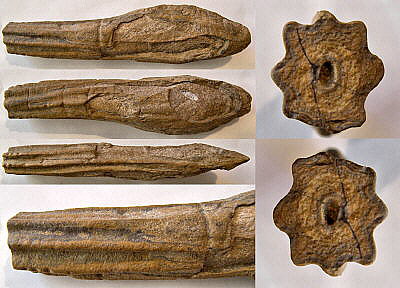Stromatoporoid
Aulacera plummeri (1843)
Calcareous
sponge
Ordovician - Indiana
Click on pictures to Magnify
Stromatoporoid
- Aulacera plummeri (1843)
Ordovician - Cincinnatian Series - Maquoketa Group - Dillsboro, Indiana
Measures 9" x 2.5" x 1.5"
Special thanks to Scott Morrison for the images and documentation on his very
interesting fossil.
These organisms, looking like weathered fence posts, belong to Aulacera. They
are unusual because the knobby surface texture is preserved as well as the
pronounced longitudinal ridges. The largest Aulacera found is two metres long
but, in life, they may have stood erect and five metres high. This would make
these stromatoporoids the tallest organic constructions in the Ordovician
seas.
Royal BC Museum - www.livinglandscapes.bc.ca/cbasin/fossils/deep_time.html
Viewer Comments:
I appreciate seeing those photos of the fragmentary
tree trunk-like skeletons of cylindrical stromatoporoid sponges from the Late
Ordovician of southeastern Indiana. These are probably best assigned to the
genus Aulacera of the Family Aulaceratidae (Order Labechiida). I suggest they
are from the Ordovician because in other occurrences where good stratigraphic
records exist (especially Anticosti Island in Eastern Canada), in North America,
Siberia, Novaya Zembla (Arctic Russia), China and Tasmania, they are never
found in the Silurian. Indeed they are widely believed to have become extinct
during the major Ordovician-Silurian mass-extinction event.
Use of the generic name Aulacera Plummeri 1843 is preferred on grounds of
priority over Beatricea Billings 1857. Even Schuchert's (1919) sketch of Plummer's
original specimen (from Indiana) shows the prominent spiraling longitudinal
ridges that your specimens display and they occur in the type species A.
plummeri Galloway & St Jean, 1957 (see illustration in J.J. Galloway's
1957 paper). There are some other species, like A. radiata and
A.undulata, that also exhibit the prominent longitudinal ridges.
More work needs to be done on the taxonomy of the cylindrical Aulaceras. Paul
Copper (Laurentian University, Sudbury, Canada) has the best collections and
plans to describe the taxonomy of the Anticosti faunas. In places on Anticosti
they form "fossil forests". See also Stearn et al. (1999).
The Treatise, part E (sponge) volume that includes the section on the Class
Stromatoporoidea is now being edited and will hopefully be published in a
year or so (Webby, in preparation).
Barry Webby
References:
Cameron, D. and Copper, P., 1994, "Paleoecology of giant Late Ordovician
cylindrical sponges from Anticosti, E Canada", in van Soest, R.W.M.,
van Kempem, T.M.G. and Braekman, J.-C. (eds.); Sponges in Time and Space;
AA Balkema Co., Rotterdam and Brookfield, Vermont, p.13-21.
Galloway, J.J., 1957, Structure and classification of the Stromatoporoidea;
Bulletin of American Paleontology, vol. 37 (No.164), 141 p. [see p. 470 and
Plate 37, fig. 1a, for illustration of A. plummeri].
Stearn, C.W., Webby, B.D., Nestor, H.and Stock, C.W., 1999, Revised classification
and terminology of Palaeozoic stromatoporoids; Acta Palaeontologica Polonica,
vol. 44, n. 1, p. 1-70.
http://www.app.pan.pl/archive/published/app44/app44-001.pdf
Webby, B.D. (Coordinating Author) Porifera (Revised), vol. 4: Hypercalcified
Porifera (chiefly Stromatoporoids, Chaetetids, and Archaeocyathids) In Preparation:
Winter 2009/Spring 2010.
Go-Back
Fossil Menu
Other
Fossils (USA and World Wide)





